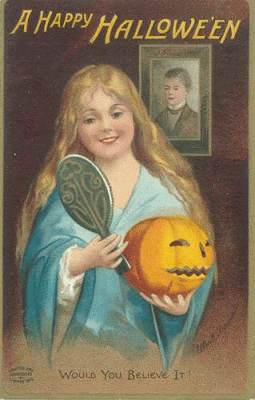Sit back, My Friends, pour yourself a libation, and gather round the campfire, for this is an olden story of the real history of Halloween....a tale as mesmerizing as anything in history....
The history of Halloween is really the story of olde
r cultures, particularly
Europe, Ireland and Britain...where the ancients heeded, and feared concepts of the dark, and the dead. As Winter drew near, and the sun-set earlier and earlier, the fear was that the sun would not return, and so ceremonies were created to beckon back the light, bonfires were lit to mimic the light and heat of that sacred orb, and rituals held during that time.
Amongst some pagan peoples, this age was known as their New Year, when magic was at it's highest point. Communing with nature, the ever feared witch still has a recognized place in modern Halloween imagery, and this includes witches, cauldrons brooms, and black cats, which were often considered witches in disguise (because, clearly, according to old superstition, witches could change themselves into animals). Hexes to bring luck or "unluck" are believed in, even to this day.
Amongst the Celts (ancient Irish) and other Europeans, this time was honored (or feared!) as the time when the thread between the living and dead was thinnest, and that the dead could rise, and wander the countryside, and commune with those of us that were alive. There are two specific rituals created in response to this...
One is the Dumb Supper, in which a family would create a special meal in honor of a lost loved one, and even set a place at the table (sometimes the head of the table) for their dearly departed, including serving food to the invisible guest, or then leaving a plate of goodies (and sometimes even coins and wine) outside the door of the house, for wandering spirits.
The reason it is called a DUMB Supper is that those attending such a dinner would then eat the entirety in silence, perhaps internally remembering their own special memories with the departed. DUMB in early eras was used to signal that someone could not talk (such as in the phrase "Deaf and Dumb" which was a slang characterization of either a deaf person, or someone with a mental deficiency, where the word dumb eventually became another term for "stupid")
In any case, the silence was a means of paying respect to their departed and keeping oneself silent also allowed one to reflect on their lost loved ones in thought and meditation.
In Mexico, in particular, this tradition has become quite huge (and even outlandish, in some ways), in a celebration known as
Dia De Los Muertos,
held on November 2nd. It's a huge celebration of one's dead beloveds,
but with an almost flippant tone--where calavaras (skeletons) rule, and
sugar skulls, skull costumes, and pan de muertos ('
bread of the dead,' a sort of soul cake/bread) is served.
Meanwhile, back in Europe, the other process resulting in the mingling of the dead was costuming oneself on this sacred day. The costumes were ghoulish, in order to blend in with the ghosts and dead spirits (if you looked like them, they wouldn't bother you or recognize you), or to hide from their wrath.
From there, the holiday took on a life of it's own. By the Victorian era, it had morphed into a social event, with formal invites and parties, and dressing up...now done mostly by children. Food and sweets were the name of the game...however....fortune telling was rife throughout--with "spells for foretelling your future spouse" a big hit amongst these, perhaps a nod to faraway witchery. Oddly, printed paraphanalia of such things (such as the Victorian card, below), strongly hint at this paganish past, romantically colored over in Victorian style:
Children would meanwhile go "masking" from door to door for sweets or
coins. Games of chance and skill, such as bobbing for apples, were
played. Lanterns, costumes, and hangings made of crepe and colored paper
were the rage....
Victorian children in costume.....
And those, my lovelies, were the beginnings of our modern Halloween! Enjoy it, wherever you are!
TOMORROW! LITTLE KNOWN FACTS and
HISTORICAL photos of HALLOWEEN!





















































